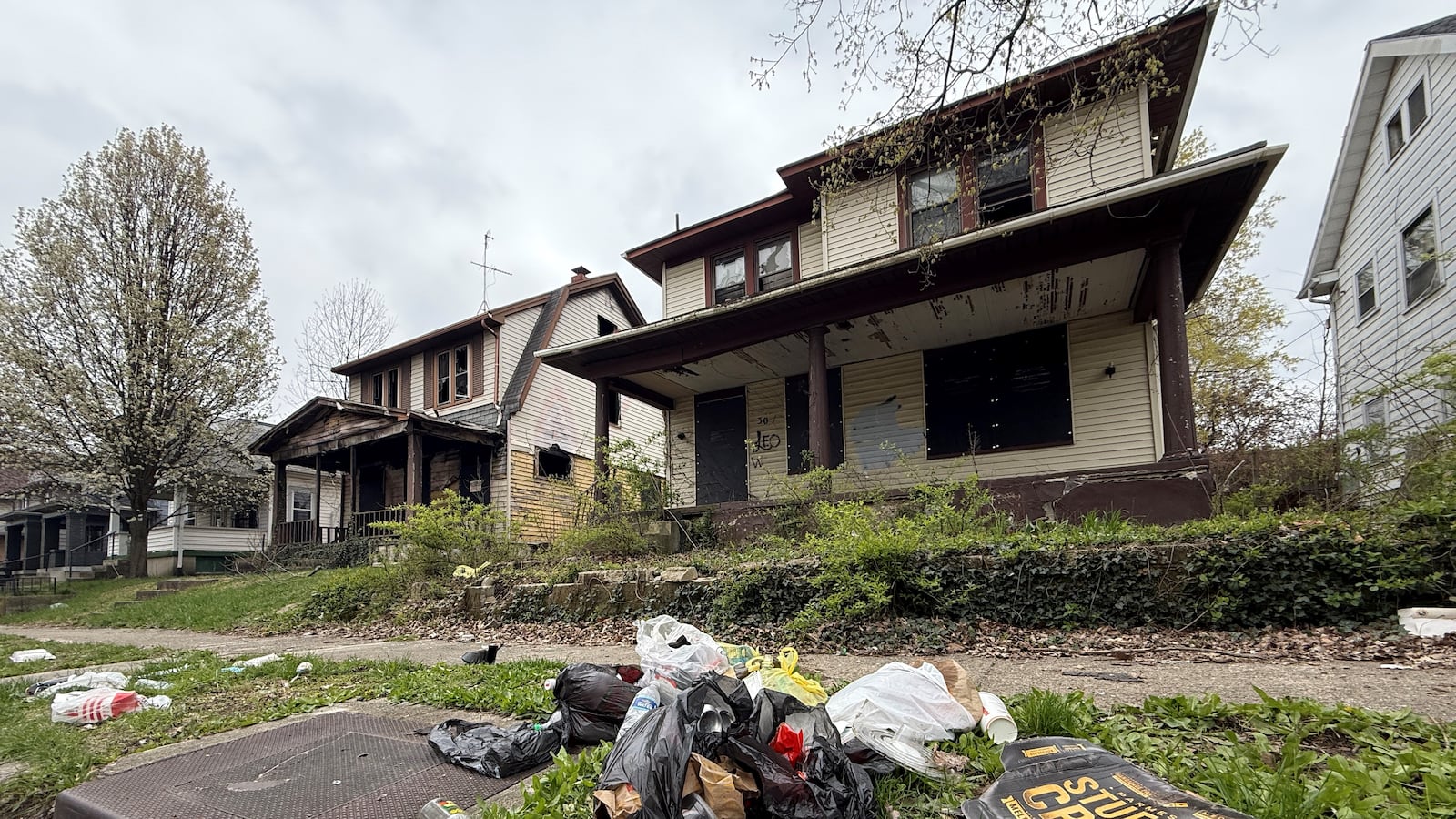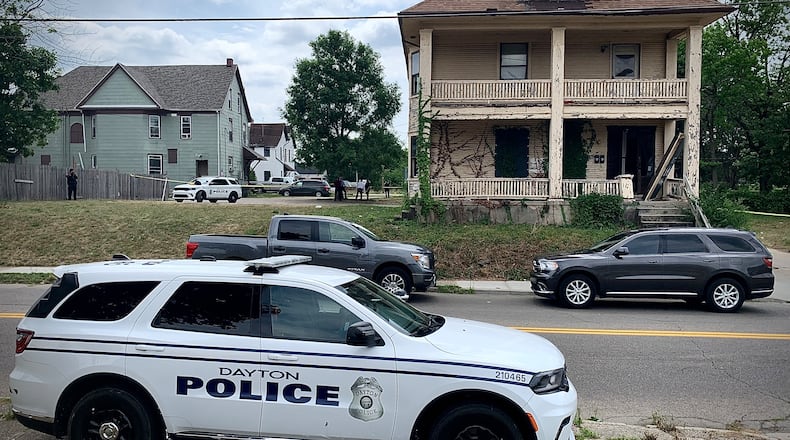A Dayton Police Department analysis of homicides and felonious assaults from 1999 to 2024 found Miami Chapel, Santa Clara and the Summit Square apartment complex have long been hot spots.
Santa Clara Neighborhood Association President Gloria White said gun violence happens all over the city, and her neighborhood has many of the same problems as other areas, like blight, trash, squatters and irresponsible property owners — except possibly to a greater extent.
Police data suggests that around three-fourths of Dayton neighborhoods had violent gun crimes with injuries last year.
“You can be shot any time, any place in America today,” White said, adding that she’s more worried about food insecurity and neighbors losing services and benefits that they need over being shot.
Sharon Mitchell, president of the Residence Park Neighborhood Association, said she’d like to see more people in Residence Park work together and look out for each other and report suspicious activities and crime.
Mitchell said some shootings in Residence Park last year were drug-related, and criminals in the drug trade try to operate in areas where they think they can get away with illegal activities.
“If you’ve got some neighbors that are constantly watching and looking around, and everybody knows everybody, more than likely they’re not going to come on that street,” she said. “We’ve got to stick together — it’s about neighbors helping neighbors.”
A 2024 citywide survey found that many Dayton residents are worried about firearm violence, and more than half of respondents concerned with gun violence said the issue is being addressed poorly.
In a sit-down interview with the Dayton Daily News, city Police Chief Kamran Afzal explained how the city is implementing a violence interruption effort and utilizing technology to address historic crime hot spots. He said efforts are limited by police staffing shortages the department is working to improve this year.
Credit: Bryant Billing
Gun violence is “not just a police issue — it’s a community issue, it’s a municipality issue, and we have to work to understand why does crime occur in a particular neighborhood,” Afzal said. “Bill Clinton said a long time ago, ‘It’s the economy, stupid.’ That hasn’t changed.”
Studies show historic housing discrimination, racism, segregation and concentrated disadvantage are associated with gun violence and deaths.
Dayton neighborhoods with the most violent gun crimes last year are predominantly Black and tend to have higher poverty and housing vacancy rates and lower levels of educational attainment and employment than the city overall, according to this newspaper’s analysis of U.S. Census data.
Gun violence hot spots
Dayton Police Department data shows there were about 135 incidents of violent gun crime with injuries in 2024.
Most of these events were shootings. But the data also includes incidents where an injury occurred and the suspect had a gun, like if someone was struck or beaten with a pistol.
Dayton divides the city into five “land use” areas (also known as councils): southeast, northeast, downtown, west and north central. North central is the northwest part of Dayton.
About 57 violent gun crimes with injuries last year took place in the northwest geography, and 50 occurred in the west geography (79% of the total), according to police data analyzed by this newspaper. About 10% of violent gun crime occurred in the southeast area; 7% occurred in northeast; and 3% took place downtown.
Four in 10 Daytonians live in the west and northwest geographies (41% of the population), according to data from the 2020 Census.
The Residence Park and North Riverdale neighborhoods were among those last year with a high number of gun crimes leading to injury, according to Dayton Police Department data.
Afzal said the police department pulled 26 years worth of crime data to create a heat map that shows the most common locations of firearm-related homicides and felonious assaults.
He said since 1999 gun violence has been notably clustered in the Santa Clara area around the North Main Street corridor in northwest Dayton, and the Miami Chapel area in West Dayton, which is home to the DeSoto Bass Courts public housing complex.
The heat map also says the Summit Square apartments in northwest Dayton has been a gun violence hotspot.
DAYTON GUN VIOLENCE
A project from the Dayton Daily News

A Dayton Daily News investigation found several neighborhoods in west Dayton have been hot spots for violent crime for more than a quarter century.
Neighborhood conditions
A study by the U.S. Department of Justice found that people who live in poor households are more than twice as likely to be victims of violent crime than people who live in high income households.
Dayton in the recent past has had one of the higher poverty rates in the nation, among mid- to large-sized urban areas. The Gem City’s poverty rate stands at about 27%.
Poverty rates are even higher in neighborhoods like Miami Chapel (42%), Edgemont (42%), part of Westwood (37%), Residence Park (28% to 29%) and Cornell Heights (28%), according to this newspaper’s analysis of Census tract data.
Poverty rates were lower than the city as a whole in Southern Dayton View (26%), North Riverdale (25%) and other parts of Westwood (23%).
Census data show that Dayton’s median household income is about $46,000, which is significantly lower than the median income for the nation ($80,610).
Median household incomes are even lower in North Riverdale ($32,700); Edgemont ($32,300); and Miami Chapel ($24,600). Residence Park and Westwood, which are spread across multiple Census tracts, have median incomes that range from $29,900 to $38,800.
Median household incomes were higher in Cornell Heights ($47,800) and Southern Dayton View ($45,200).
Census tract data also indicate that between 83% and 92% of residents are Black in the Residence Park, Westwood, Cornell Heights, Edgemont, Miami Chapel and Southern Dayton View neighborhoods. And about 63% of North Riverdale residents are Black.
Citywide, about 41% of residents are Black, while 48% are white. Research has found that firearm crime disproportionately affects Black communities across the nation.
Across the entire city, a quarter of residents have bachelor’s degrees. But the educational attainment rate is 14% or lower in the seven aforementioned neighborhoods. Also, most of these neighborhoods have lower employment rates and higher housing vacancy rates than the city as a whole.
Experts weigh in
Mark Kaplan, a research professor at the UCLA Luskin School of Public Affairs, said studies and research show that homicide rates around the globe are highly correlated with income and wealth inequality.
Areas with high levels of gun violence usually are segregated, disadvantaged and have a large share of residents who are Black or who are members of other minority groups, he said.
The most impacted areas tend to be “neglected, they are under resourced, the social safety net in those communities if you can speak of one often is in tatters,” he said, adding that a “constellation of interrelated pathologies” contributes to gun violence and where it takes place. “These are deprived communities.”
Credit: Bryant Billing
Kaplan said he believes inequality in America will get worse in coming years if proposed tax cuts pass that primarily benefit more affluent households and tariff policies are in place that basically serve as regressive tax.
Unfortunately, “we are moving toward a more unequal society, and if you trust the data that’s published over many years, inequality is toxic and can only lead to a surge in gun violence,” he said. “When we look at homicides, it follows the contours of segregation and social economic deprivation — it doesn’t occur randomly.”
Santa Clara Neighborhood Association President White said some shootings in her neighborhood over the years have happened along North Main Street, including a shooting last year outside a bar on the heavily traveled corridor. She said some violence has taken place at gas stations and outside other businesses.
White said Santa Clara continues to have issues with trash in the alleys; vacant and blighted homes; and squatters and homeless people living inside empty properties. She said properties have been neglected by irresponsible owners, including LLCs and out-of-state individuals.
White said Santa Clara was clobbered by a wave of foreclosures after the housing bubble burst, leading to property abandonment and neglected homes. The neighborhood was “ground zero” of the state’s foreclosure crisis in the late 2000s.
Credit: Chris Stewart
Credit: Chris Stewart
“We were hit hard, and we’re coming out of that slowly,” White said. “It’s about having patience.”
Dayton has torn down a significant number of decaying homes in Santa Clara, which White says has helped, and the city is targeting more residential properties for demolition.
However, Census data still indicate that one in three housing units in Santa Clara are vacant (33%), compared to about 16% of units citywide.
About one-third of residents in the Santa Clara area live in poverty, and more than seven in 10 residents are Black.
‘Keeping your mouth shut is not working’
Mitchell, a minister and the neighborhood association president, said overall the Residence Park neighborhood is a safe place to live. But she said it’s unfortunate that last year there were multiple shootings tied to illicit drug activities and family violence.
Mitchell said she believes Residence Park would have less crime if more residents stepped up to share information, watch out for each other and take part in some kind of neighborhood watch program.
“If we could just get people to understand that they need to be involved,” she said. “Keeping your mouth shut is not working. ... If I see something, I’m going to say something.”
Mitchell said residents and stakeholders in the neighborhood are trying very hard to try to make the area better. She said recent and forthcoming investments include park upgrades, a new mural and welcome flags.
But Mitchell said Residence Park continues to have very visible problems with trash, illegal dumping and blight. She said these kinds of conditions often send the wrong message that people don’t care about their neighborhood, which invites other kinds of problem activities.
“We’re doing a lot of things to uplift the neighbors so they won’t think that no one cares about Residence Park,” she said.
About the Author







